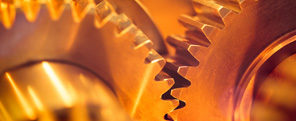 |
|||||||
|
Gear cases, usually made of aluminum or steel, house gear systems that change the direction of mechanical energy that's input to the gear assembly. Though gear operation is usually enclosed and not visible during system operation, inspecting and maintaining gear box lubrication is vital to the successful operation and longevity of equipment, and to controlling costs. It's all about smooth gear operation, after all, and in order to achieve this, shop personnel are the first line of defense in maintaining the gear case. The two most common symptoms of gear case problems are an increase in noise coming from the gear case and a tendency to overheat. Inspect for Color, Foam, Blockages, Leaks Check fasteners to insure they have not loosened during operation. Also, inspect the breather and shaft seals of the gear case. The breather will likely include a filter and desiccant to prevent dust and moisture from entering the gear case. If you wash the gear case, take pains to shield the breather from water. Look also for oil leaks at the shaft seals. If oil is coming out, dust and moisture are surely getting in. Overheating can be more difficult to detect. Inspection and maintenance personnel should watch for smoke from shafts, seals or breathers. They should check for discolorations on painted surfaces, or color changes on unpainted surfaces. Any deformed or melted plastic parts in the vicinity are a symptom of overheating. When examining the visual porthole of the gear case (or a dipstick), be sure there is sufficient oil in the case. An infrared heat gun can be used to check performing temperatures if you can safely remove the gear box during operation. One of the best ways to know if your gear box is going to have problems is by performing regular oil analysis. Specialized Tools Of course, many assume that a housed gear assembly is perfectly aligned, gear shafts are true and gear teeth are engaging perfectly across their entire width. All the gear case inspection in the world will come to naught if the gears are mis-aligned and wearing unevenly, so check for wear patterns on the gear teeth to see if there are issues with the equipment itself. The Best Long-term Strategy
|

|
||||||
|
|||||||
|
|||||||
Accurate Lubricants & Metalworking Fluids, Inc.• 403 Homestead Avenue; Dayton, Ohio 45417 USA • Phone: 937-461-9906 Fax: 937-461-9917
|
|||||||
